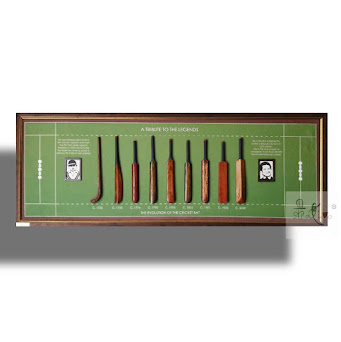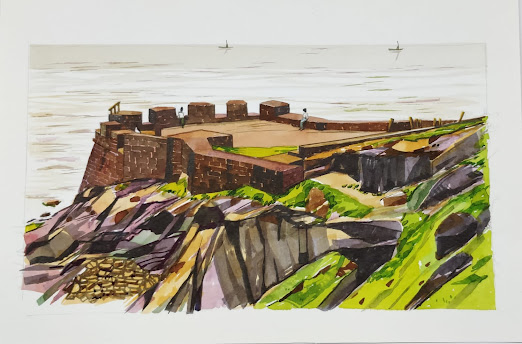A Tribute to The Legends
A TRIBUTE TO THE LEGENDS - EVOLUTION OF THE CRICKET BAT
Cricket has fascinated me since my childhood. From playing 'one bounce' to underarm, with a tennis ball or rarely, a season ball, cricket is one of the sports that kept me occupied as a kid. I recollect playing the role of a fielder incessantly, occasionally a bowler but seldom that of a batswoman, with my brother, immediate neighbours and some close friends forming the teams.
Furthermore, it is indeed nostalgic to recall the time I spent as a kid amidst my siblings, cousins and elders watching the most memorable 1983 World Cup cricket series on a monochrome television at my maternal grandparents' house. Since then, the passion has grown so much that I have rarely missed watching any important cricket match in which the Indian Cricket Team participated.
While we were in London on vacation a few years ago, my family, on my insistence, visited Lord's Cricket Stadium (also called the Mecca of Cricket), to watch a cricket match played between England and the West Indies. It was indeed soul-satisfying and will be cherished throughout my life.
As we were making the best use of our time on the ground, I came across a
magazine describing the history of cricket bats and also an art piece depicting the same. Having an inclination towards creative things, at the back of my mind it inspired me to do something dedicated to cricket and its players, someday.
As I now go down the memory lane, I never imagined that one day such a fascinating cricketer 'Jimmy', the hero of our nostalgic moments of 1983' world cup, would ever become a very close family friend.
So, after a few weeks of our return form London, Mr Mohinder Amarnath or ‘Jimmy’ as he is fondly called by his fans, visited us at home. I vividly remember discussing my experiences at the Lord's Cricket Ground.
Jimmy narrated his overwhelming experiences of the India's first world cup win. He was the 'Man of the Match' in the semifinal against England and in the final against the West Indies as well.
Jimmy always keeps us engrossed in interesting cricketing stories of the glorious past, including that of his father, the legendary Lala Amarnath and his childhood.
Recently, on one such occasion, I enquired about his priceless possession, the '83 World Cup bat and ball. In the discussion that followed, the thoughts of the Lord’s cricket ground poured in, the dots connected, and I decided to recreate this beautiful piece.
A detailed study strengthened my confidence during the creation of these miniature
cricket bats depicting their evolution, which are painstakingly hand-crafted by our craftsmen using the best quality of wood.
The first piece has been dedicated to the two Legends of Indian Cricket, Mr Lala Amarnath of the yesteryears, and our 'Master Blaster' Mr Sachin Tendulkar. This piece of craft is for every cricket lover.
Journey of the cricket bat:
Although the first forms of cricket are lost in the mists of time, it may be that the
game was first played using shepherds crooks. Until the rules of cricket were formalised in the 19th century, the game usually had lower stumps, the ball was bowled underarm, and batsmen did not wear
any protective gear, as they do nowadays. As the game changed, it was found that a differently shaped bat was better suited.
Today, the cricket bat is shaped something like a paddle, consisting of a long, padded handle. This widens into the blade of the bat, a wider wooden block, flat on one side and with a V-shaped ridge on the other, to provide greater air flow in the follow through. However the more important reason for the ‘V’ in the back is for an increased power to weight ratio, as it removes wood from areas where it isn't needed while leaving the bat thick enough in the middle region where the ball is generally hit. The flat side is used to hit the ball. The point at which the handle widens into the blade is known as the shoulder of the bat, and the bottom of the blade is known as the toe of the bat.The cricket bat is traditionally made from willow wood, specifically from the English Willow, treated with raw linseed oil.
Its use is first mentioned in 1624.
This wood is very tough and shock resistant, not being significantly dented, or splintering on the impact of a cricket ball at high speed, while also being light in weight.
In late 2008, South Asian Federation (SAF) Sports created a cricket bat with an offset edge. This allowed for an extended middle, better swing weight and increased performance without compromising the bats balance.
The production models were available in 2009, and the bat won awards in 2010 and 2012.
The size of the bat is not more than 965 mm long and the blade may not be more than 108 mm wide. Bats typically weigh from 1.1 to 1.4 kg. The handle is usually covered with a rubber or cloth sleeve to enhance grip, and the face of the bat may have a protective film. Modern bats are usually machine made, however a few specialists still make hand-made bats, mostly for professional players. The art of hand-making cricket bats is known as ‘Pod shaving’.
*Source: Wikipedia
Many thanks to my team for putting their heart and hard work into the making of this beautiful product, as well as to the artists and craftsmen who carefully and passionately crafted each piece to perfection.
Special thanks to a former Goa Ranji cricket player and my dear friend Kapil for encouraging me to forge ahead with the process of creating this piece of art.
A limited edition of the same will be created for the ardent cricket lovers!
 |
| Add caption |























Its really a tribute to cricket lovers 👍👍
ReplyDeleteSuper cool 😎 👌
You are too good Roopa
Thank you so much 🙏🙏
DeleteGreat , unbelievable
ReplyDeleteI am speechless
Thank You so much 🙏
DeleteGreat , unbelievable
ReplyDeleteI am speechless